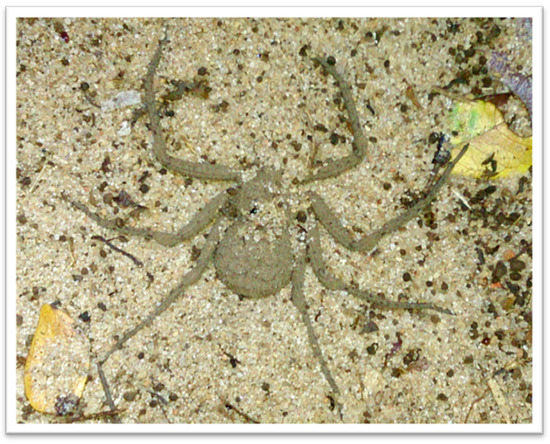- Joined
- Dec 29, 2012
- Messages
- 1,066
Before I get into the topic of this thread, let me first state that I am in no way, shape, or form condoning keeping these arachnids without taking extreme care and precaution. No one should even consider it without years and years of experience with fast and defensive spiders. I understand that Phoneutria DO have extremely potent venom and ARE capable of killing a person. I also know there’s a sticky thread specifically talking about Phoneutria but it mainly delves into care. If I have any of the information in this thread incorrect, feel free to KINDLY correct me. With that in mind:
These spiders are often regarded as being among the most dangerous/deadly arachnids on the planet, and that’s what has always kept me from keeping them. I’ve had pretty much every other Ctenidae species imaginable because quite frankly they are my favorite family of true spiders by a long shot. Their hunting techniques are absolutely fascinating to watch and they also have gorgeous color. Lately I’ve done a bit of research on their venom because I am interested in eventually keeping Phoneutria but also because I’m just fascinated by toxicology. Most of the statistics I have found seem to suggest that Phoneutria are in fact a tad bit overhyped. Fast, agile, and packing extremely strong venom? Sure. Something that should be absolutely reserved for experienced keepers? Sure, but how much more deadly than your average Latrodectus are they really? I have no doubt that they’re more defensive than anything in the widow family, but what about the likelihood of serious problems if bitten? Surely they can’t come anywhere close to Sicarius or Atrax.
https://spiders.ucr.edu/deadly-banana-spider-or-not
According to this source, only 2.3% of 422 documented bites required antivenin. I’m not sure if that means that the other 98% received dry bites or were just healthy enough to only experience mild symptoms. There was one death from this sample, and it was a child (definitely a high-risk category). I just can only imagine that if you took 422 randomly selected people and induced a bite from a Poecilotheria, Stromatopelma, or even the aforementioned Latrodectus, you would get similar results in terms of mortality. I suppose one way or another, it’s still a massive risk no matter how cautious you are. Sicarius, for instance, have become quite popular in the hobby despite being possibly the most potent Araneomorph in existence (I realize that they are highly reluctant to bite, but still a dangerous spider regardless). I genuinely hope this thread doesn’t turn into an all-out war zone. That being said, I’m very curious what some of the veterans have to say. If any of you have kept Phoneutria, I’m curious to know how their temperament/speed compares to other Ctenids such as Cupiennius (moved to another family), Macroctenus, or Piloctenus. Are they something that experienced, cautious keepers can handle or should they be avoided at all costs? I have no plans to acquire these spiders anytime in the near future, but perhaps eventually when I’ve gathered enough concrete knowledge on them.
These spiders are often regarded as being among the most dangerous/deadly arachnids on the planet, and that’s what has always kept me from keeping them. I’ve had pretty much every other Ctenidae species imaginable because quite frankly they are my favorite family of true spiders by a long shot. Their hunting techniques are absolutely fascinating to watch and they also have gorgeous color. Lately I’ve done a bit of research on their venom because I am interested in eventually keeping Phoneutria but also because I’m just fascinated by toxicology. Most of the statistics I have found seem to suggest that Phoneutria are in fact a tad bit overhyped. Fast, agile, and packing extremely strong venom? Sure. Something that should be absolutely reserved for experienced keepers? Sure, but how much more deadly than your average Latrodectus are they really? I have no doubt that they’re more defensive than anything in the widow family, but what about the likelihood of serious problems if bitten? Surely they can’t come anywhere close to Sicarius or Atrax.
https://spiders.ucr.edu/deadly-banana-spider-or-not
According to this source, only 2.3% of 422 documented bites required antivenin. I’m not sure if that means that the other 98% received dry bites or were just healthy enough to only experience mild symptoms. There was one death from this sample, and it was a child (definitely a high-risk category). I just can only imagine that if you took 422 randomly selected people and induced a bite from a Poecilotheria, Stromatopelma, or even the aforementioned Latrodectus, you would get similar results in terms of mortality. I suppose one way or another, it’s still a massive risk no matter how cautious you are. Sicarius, for instance, have become quite popular in the hobby despite being possibly the most potent Araneomorph in existence (I realize that they are highly reluctant to bite, but still a dangerous spider regardless). I genuinely hope this thread doesn’t turn into an all-out war zone. That being said, I’m very curious what some of the veterans have to say. If any of you have kept Phoneutria, I’m curious to know how their temperament/speed compares to other Ctenids such as Cupiennius (moved to another family), Macroctenus, or Piloctenus. Are they something that experienced, cautious keepers can handle or should they be avoided at all costs? I have no plans to acquire these spiders anytime in the near future, but perhaps eventually when I’ve gathered enough concrete knowledge on them.



